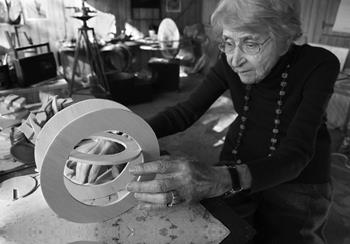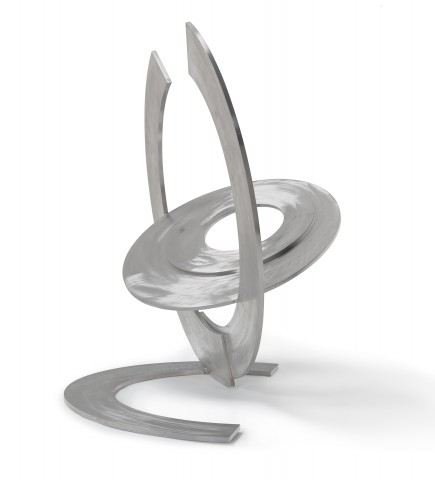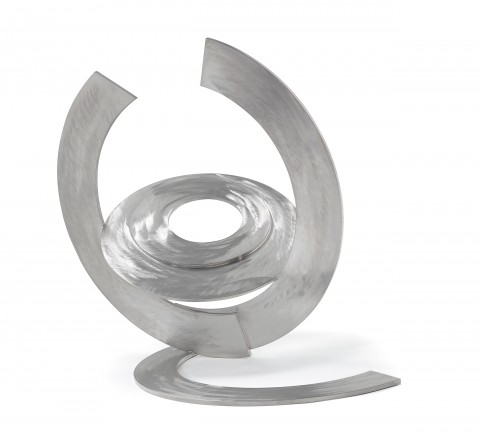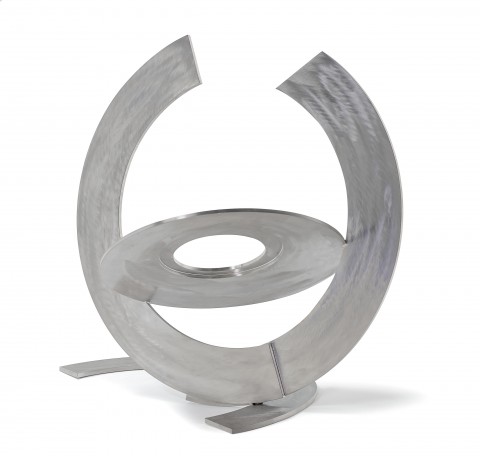PLANET, 2009
INGE KING
stainless steel
73.0 x 82.0 x 65.0 cm
signed with initials at base: IK
Australian Galleries, Melbourne
The National Australia Bank Art Collection, acquired from above in 2009 (label attached to base)
Inge King: Sculpture: Maquettes and Recent Work, Australian Galleries, Melbourne, July - September 2009
Grishin, S., The Art of Inge King Sculptor, Macmillan Art Publishing, Melbourne, 2014, pp. 280 – 281 (illus.), 358, 379
Scarlett, K., 'Tough and Dedicated', Australian Art Review, Sydney, February – April 2010, p. 48 (illus.)
Rings of Saturn, 2005 – 06, stainless steel, 450.0 x 450.0 x 450.0 cm, in the collection of the Heide Museum of Modern Art, Melbourne
Sun Dance, 2009, stainless steel, 89.0 x 126.0 x 107.0 cm, in the collection of Central Steel Equity, Melbourne
210749.jpg

At the time of her death in 2016 at the age of 100, Inge King’s work had transformed her hometown of Melbourne, with her monumental sculptures such as Forward Surge, 1974 at the Arts Centre, Shearwater, 1994 – 95 at Southbank, and Sentinel, 2000 on the Eastern Freeway, becoming iconic city markers – recognised by tens of thousands of people, even if they remained unaware of the name or extraordinary achievements of the artist who made them.
When King emigrated to Australia with husband and fellow artist Grahame in 1951, she had already trained in Berlin, Glasgow, London and New York, accumulating considerable experience as a sculptor. Just two years later, she was one of the founding members of the Group of Four (along with Julius Kane, Clifford Last and Norma Redpath), which was established with the collective desire to create a sympathetic relationship between modern abstract sculpture and architecture. The Group was joined by Vincas Jomantas, Lenton Parr and Teisutis Zikaras in 19611, becoming Centre 5 – a seminal coterie that continued to champion a greater appreciation of modern sculpture and the inclusion of ambitious sculpture in contemporary Australian architecture.
As one of the first Australian sculptors to learn to weld2, King began to work exclusively in welded steel from the mid-1960s, creating work that could withstand Australia’s harsh conditions and hold its own in what seemed to her to then be a ‘strange, untidy landscape.’3 However, over time, she came to love and better the understand the Australian bush, with its cast of unique birds becoming part of her lexicon of totemic figures in the 1990s. As art historian Jane Eckett has surmised, ‘Her sculptures arose simultaneously from international modernism and from local environments, both natural and urban. With their monumental forms and impeccably smooth surfaces, they appeared products of a high formalist aesthetic. Yet her work refused such compartmentalisation, regularly returning to the figurative and the improvised, experimental – even joyful – nature of assemblage. Inge herself wisely accepted these contradictions, charry of rigid theorems’.4
Planet, 2009 is part of a series of ambitious ‘interstellar’ sculptures known as the Celestial Rings, 2004 – 14 which were inspired by televised images of outer space transmitted from the Hubble Telescope.5 These works were initially conceived in balsa wood by King and then cast in bronze and used as maquettes for larger works which were created by experienced fabricators. At scale, their commanding presence conveys an artist at the height of her powers; one with an extraordinary formal capacity, technical knowledge, and uncompromising eye. As she has said, ‘With the Celestial Rings series I begin by working on a small scale because it’s fast. Also, by doing this I am able to discover what will work on a large scale. I have a definite feeling for scale – I have a definite instinct of what will enlarge and what will not’.6 With its intersecting rings and planes of highly polished stainless steel, Planet encapsulates a sense of energy and movement, encouraging the viewer to do the same. This is a work to be experienced bodily, and in the round.
1. The exact date of Centre 5’s formation has been long contested. This is the date ascertained by Jane Eckett from Lenton Parr’s diaries in his papers in the State Library of Victoria, Melbourne. See Eckett, J. ‘Binary Star: Inge and Graham King’ in Hurlston, D. & Eckett, J., Inge King: Constellation, National Gallery of Victoria, Melbourne, footnote 60, p. 119
2. Scarlett, K., ‘Tough and Dedicated’, Australian Art Review, Sydney, February – April 2010, p. 48
3. Lancashire, R., The Age, 31 September 1992 as quoted at https://igking.info/inge-king-2/inge-king-the-early-years/ (viewed 18 December 2021)
4. Eckett, J., ‘Inge King: Full Circle’ in Inge King 26 November 1915 – 23 April 2016, booklet for memorial held at the National Gallery of Victoria, Melbourne, 9 May 2016, n.p. See http://igking.info/wp-content/uploads/memorial-booklet.pdf (viewed 18 December 2021)
5. Eckett, J., ‘Inge King Memorial Service’, http://igking.info/wp-content/uploads/Inge-King-eulogy-Jane-Eckett.pdf (viewed 18 December 2021) This series also includes the monumental public sculpture Rings of Saturn, 2005-06, which is sited at the entrance of Melbourne’s Heide Museum of Modern Art.
6. Hurlston, & Eckett, op. cit., p. 90
KELLY GELLATLY


